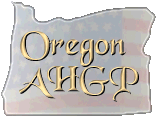|
He who would attempt to understand his pioneer ancestors, their life and their work, must first know some of the historic circumstances which brought people to the austere mountains and the remote Blue Mountain valleys. Here, at Pioneer's coming, was no railroad, no boat landing, no ready source of supply or medical attention, no cultural life, no promise of easy living, no business market, no highway. Here was only remoteness, deprivation, a raw and sometimes hostile land demanding the life blood of strong and determined and sacrificing people. Baker County's birth and adolescence contained three elements: The umbilical cord of the Oregon Trail, the birthing fever of Gold, and sustaining nourishment form mining camps and farming communities.
The Oregon Trail: Depression and restlessness in the East coupled with gold discovered in California (1849) turned masses of people westward (1841-1884) on the Oregon Trail. One branch of this trial brought people through Baker Valley, although a few had reason to stop (1841-1861).
Gold: Restless miners deserted the played-out mines of California, farmers form the Willamette valley sought the quick riches of golden metal, immigrants from the Oregon Trail unyoked their oxen and gold seekers headed eastward to the Salmon River Mines laid down their packs here. Unlike some of the Gold areas, Baker county gold was sufficiently enduring to sustain communities.
Supply: In the brief notations listed for families herein, readers will detect the influence of these and other occupations. The drift of people will be seen; the itinerant miners, the planned wagon trains (Chandler and Perkins and others), the interrupted immigrant stopping short to his Willamette Valley goal. Some came; some left; some lived; some died; some prospered and some barely existed. It wasn't easy, but each left his legacy. The Pioneer is gone, but the pioneer spirit lives on in the families and descendants, in the friendly "Hi neighbor," in their love of this land. Centennial Pioneer Families of Baker County, by Ruth H. Evans |
|
